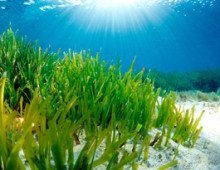Nitrogen-fixing plants provide the major biological source of nitrogen for the biosphere, and are particularly important in low-nutrient environments. Actinorhizal symbiosis is a strong contributor to global biological nitrogen fixation process. These soil bacteria are plant symbionts that have a broad host-recognition-specificity. Inter-planting actinorhizal plants with suitable tree crops allows nurse cropping of valuable tree…
Why single cell genome sequencing of mesopelagic bacterioplankton?
Considered one of the largest but least understood marine biomes, the mesopelagic zone starts some 200 meters (650 feet) below the ocean’s surface and extends another 800 meters. The temperatures in this region range from 20° Celsius closer to the surface of the water to 4° Celsius further down and oxygen levels are poor. In…
Why sequence Vibrio fischeri?
Vibrio fischeri is a toxin-producing bacterium that is often found in residing in the light-emitting organ of marine animals such as squid and fishes. It is used as a model system for studying the symbiotic relationships between bacteria and animal. For example, V. fischeri colonizes the light-producing organ on certain squid and fishes and helps…
Why sequence Halorespiring Firmicutes?
Considered the oldest multicellular animals, marine sponges are found in many tropical reef ecosystems. Unable to move from their positions on the seafloor, marine sponges can filter 24,000 liters of seawater per kilogram of sponge daily and as much as 60 percent of their biomass can be composed of microorganisms, many of which are being…
Why sequence Streptomyces viridosporus ATCC 39115 and Streptomyces setonii ATCC 39116?
Streptomyces are soil-dwelling bacteria that break down plant biomass in nature, though they may physically resemble fungi. One advantage of studying Streptomyces species is that their genomes are relatively small (approximately 10 million bases) and are usually localized to a single chromosome. Streptomyces bacteria are among a select group of microorganisms that accumulate triacylglycerols, the…
Why sequence marine bacterial genus Marinomonas?
In the Mediterranean Sea, the perennial Neptune grass (Posidonia oceanica) forms meadows that cover about 15,000 square miles of rocks and sand and is a key part of the marine ecosystem. About 30 percent of the bacteria found in Neptune grass is composed of Marinomonas strains, which include M. posidonica, considered to be the most…
Why sequence genome closure of lignocellulosic degrader Verrucomicrobium sp. strain TAV2?
Wood-feeding termites have microbial communities in their guts that are capable of converting cellulose and hemicellulose into sugars, hydrogen and methane. They can break down as much as a billion tons of raw plant biomass annually, and are of interest to bioenergy researchers hoping to harness these abilities for commercial biofuel production. To better understand…
Why sequence carbon monoxide oxidizing thermophiles?
Many microbes that use carbon monoxide as an energy source are found in high temperature environments such as geothermal areas. Researchers think that these carboxydotrophs may be involved in reducing potentially toxic carbon monoxide hotspots by combine with water to form hydrogen, carbon dioxide and acetate, which are in turn used for thermophilic energy conservation…
Why sequence rhizobia of clover, pea/bean and lupin microsymbionts?
The soil bacteria that interact with the root nodules of legumes such as beans or peas are known as rhizobia. These symbiotic bacteria contribute two-thirds of the nitrogen that is used in agricultural production. As oil prices rise, so does the cost of nitrogen fertilizers, which significantly impacts both global farming economies and bioenergy research,…
Why sequence Zymomonas mobilis transcriptomes and resequencing Z. mobilis industrial strain ZM4?
Zymomonas mobilis is currently considered as the bacterial alternative to yeast in bioethanol production and is employed in industrial fermentations in the United States, Canada and other parts of the world. The DOE JGI is currently sequencing five different strains of Z. mobilis and also multiple plasmids of industrial ZM4. This project calls for resequencing…





